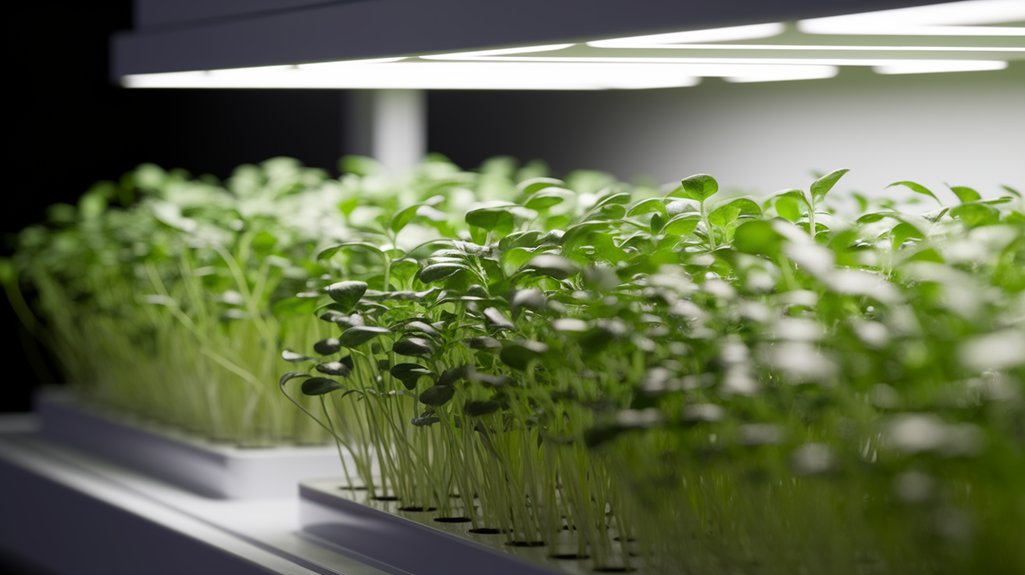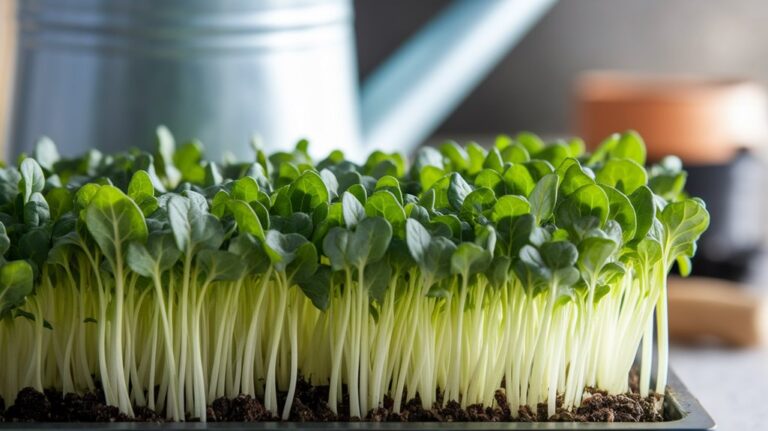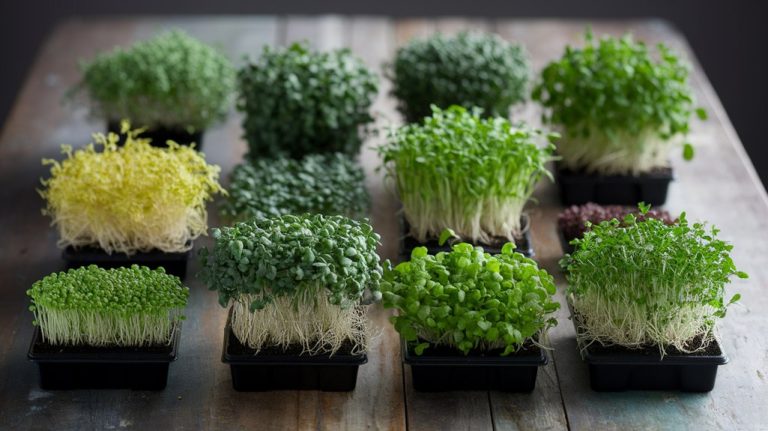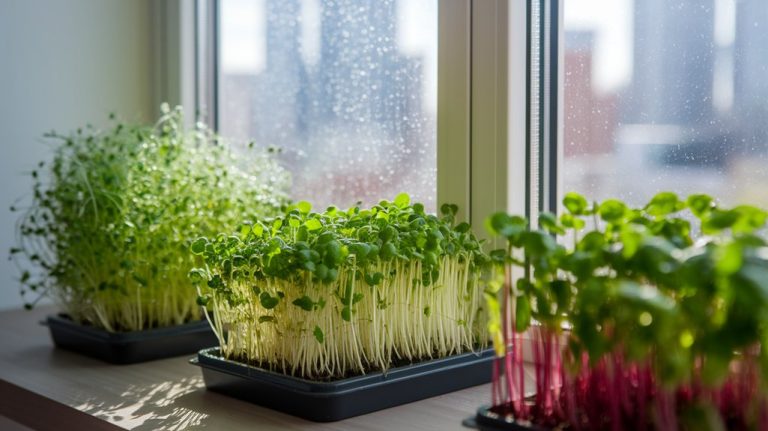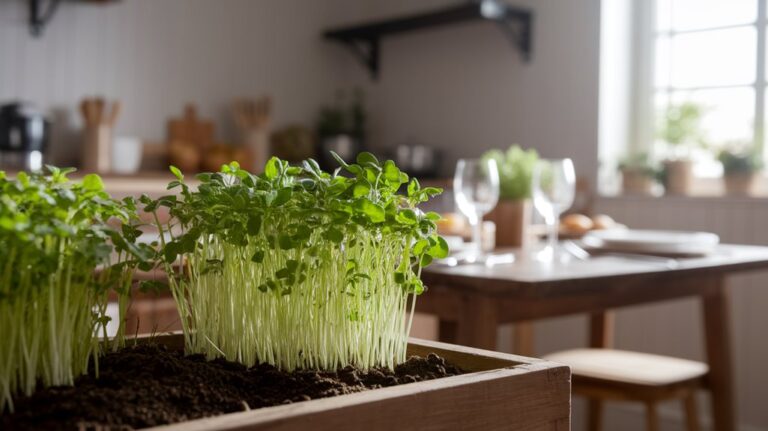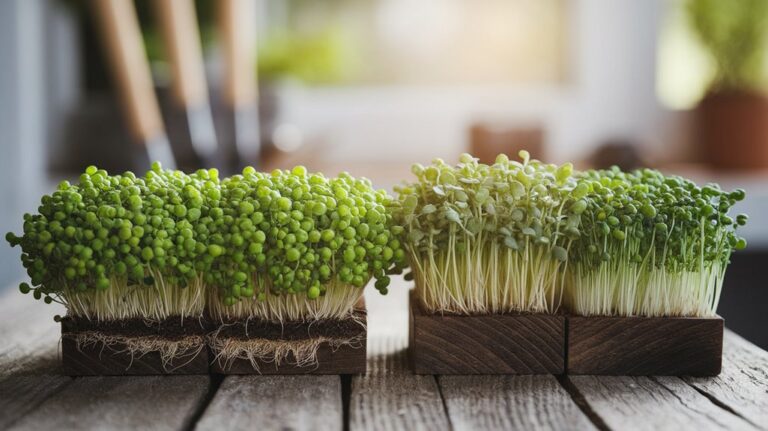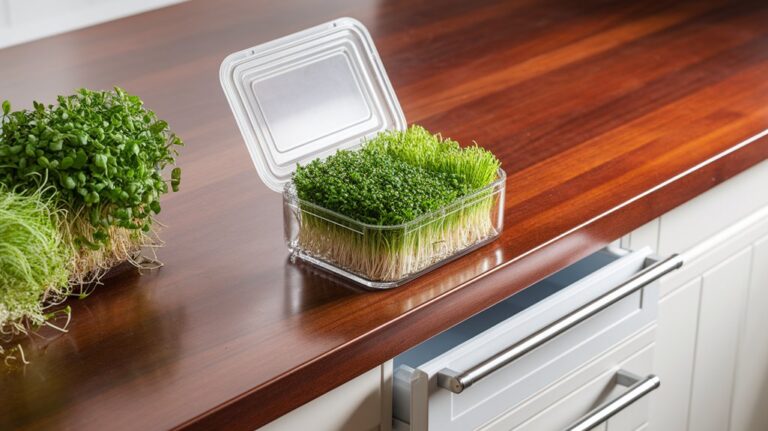Hydroponic Microgreens: Is It Worth It?
I’ve found that investing in hydroponic microgreens is worth it due to their high nutrient density and culinary versatility. These systems utilize space efficiently, making them ideal for urban gardening. The quick growth cycle allows for multiple harvests, maximizing profits, especially in local markets. While challenges like nutrient management exist, their low water use and reduced environmental impact make them sustainable. If you’re curious about the practicalities and best practices, let’s explore further.
Key Takeaways
- Hydroponic microgreens are nutrient-dense, often surpassing mature vegetables, making them a valuable addition to a healthy diet.
- They can be grown in compact spaces, making them ideal for urban gardening and maximizing yields in limited areas.
- Initial startup costs are significant, but the high market demand allows for rapid returns on investment.
- Hydroponics uses significantly less water compared to traditional farming, promoting sustainability and reducing environmental impact.
- Understanding consumer preferences and maintaining a local customer base can enhance profitability and stabilize demand for microgreens.
Understanding Hydroponics and Microgreens
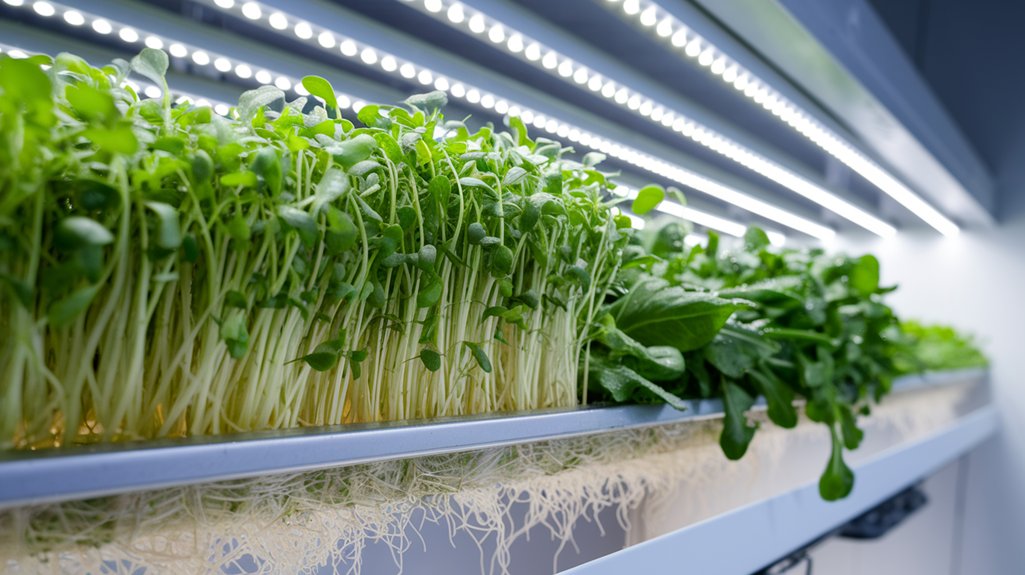
While many people associate traditional gardening with soil, I’ve found that hydroponics offers a revolutionary approach that can enhance the growth of microgreens. Hydroponics, a method of growing plants in nutrient-rich water, eliminates the need for soil, allowing for greater control over nutrient delivery and environmental factors.
Research shows that microgreens thrive in hydroponic systems, benefiting from optimized light, pH levels, and moisture. Utilizing a variety of hydroponic techniques, such as nutrient film technique (NFT) or deep water culture (DWC), I can cultivate microgreens with faster growth rates and higher yields.
This precision farming method not only maximizes space but also reduces water usage, making it a sustainable choice for urban agriculture. Understanding these principles has transformed my approach to gardening.
Nutritional Benefits of Hydroponic Microgreens
When I analyze the nutritional benefits of hydroponic microgreens, I find their nutrient density often surpasses that of mature vegetables, making them an efficient source of essential vitamins and minerals.
Additionally, their high antioxidant properties contribute to overall health by combating oxidative stress.
Their culinary versatility further enhances their appeal, allowing for incorporation into various dishes without compromising nutritional value.
Nutrient Density Comparison
Although many people overlook microgreens as mere garnishes, their nutrient density reveals a different story, particularly in hydroponic varieties. Research shows that hydroponic microgreens can pack a significant nutritional punch, often containing higher concentrations of vitamins and minerals compared to their mature counterparts.
Here’s a quick comparison of some popular hydroponic microgreens:
| Microgreen | Nutrient Density (mg/100g) |
|---|---|
| Arugula | 120 |
| Radish | 200 |
| Broccoli | 150 |
| Pea Shoots | 100 |
| Basil | 160 |
These values indicate that incorporating hydroponic microgreens into your diet can enhance nutrient intake, making them a worthwhile addition to any meal.
Antioxidant Properties
Hydroponic microgreens not only impress with their nutrient density but also shine in their antioxidant properties, which play a vital role in protecting our cells from oxidative stress.
Research indicates that these tiny greens can contain significantly higher levels of antioxidants compared to their mature counterparts. For instance, varieties like broccoli and radish microgreens exhibit elevated concentrations of sulforaphane and glucosinolates, compounds linked to anti-cancer effects.
The presence of vitamins C and E further contributes to their antioxidant profile, enhancing their ability to neutralize free radicals. This potent combination not only aids in reducing inflammation but also supports overall health.
Incorporating hydroponic microgreens into your diet might just be a strategic choice for boosting your antioxidant intake effectively.
Culinary Versatility
While many might think of microgreens solely as a garnish, their culinary versatility proves they can be a central component in a variety of dishes. I’ve found that hydroponic microgreens not only enhance flavor but also boost nutritional value. They can be integrated into salads, sandwiches, and smoothies, enriching meals with essential vitamins and minerals.
Here’s a quick overview of popular microgreens and their culinary uses:
| Microgreen | Culinary Use |
|---|---|
| Arugula | Salads and pesto |
| Radish | Tacos and sandwiches |
| Basil | Sauces and garnishes |
Space and Time Efficiency in Urban Gardening
In urban gardening, optimizing space is crucial due to limited real estate.
I’ve found that hydroponic microgreens not only require minimal growing time but also adapt remarkably well to compact environments.
This efficiency allows city dwellers to cultivate fresh produce without the constraints of traditional gardening methods.
Optimal Space Utilization
Optimal space utilization in urban gardening is crucial, especially when every square foot counts. Hydroponic microgreens offer a unique advantage in densely populated areas where traditional gardening might not be feasible. By using vertical systems and compact setups, I maximize yield per unit area.
Here’s a quick comparison of space efficiency:
| System Type | Space Required (sq ft) | Yield (oz per cycle) |
|---|---|---|
| Traditional Soil | 10 | 8 |
| Hydroponic Tray | 5 | 12 |
| Vertical System | 3 | 15 |
With hydroponics, the ability to stack layers makes it easier to grow more in less space, allowing urban gardeners like me to optimize our limited resources effectively.
Minimal Growing Time
Achieving minimal growing time is essential for maximizing efficiency in urban gardening, especially when dealing with limited space.
Hydroponic microgreens typically germinate in just 5 to 14 days, significantly reducing the wait compared to traditional soil methods. This rapid growth cycle allows me to harvest multiple batches throughout the year, optimizing my yield without requiring extensive room.
Research shows that microgreens receive higher nutrient concentrations in a shorter time frame, enhancing their value. By employing controlled environments, like LED lighting and nutrient solutions, I can further accelerate growth, ensuring that each plant reaches maturity quickly.
Integrating these techniques not only saves time but also makes urban gardening a feasible option for those with busy lifestyles and limited resources.
Urban Adaptability Benefits
While urban environments often present challenges for traditional gardening, hydroponic microgreens offer remarkable adaptability that maximizes both space and time efficiency.
In my research, I’ve found that hydroponic systems can be implemented in small areas—balconies, windowsills, or even underutilized corners of a kitchen. These systems utilize vertical space and often eliminate the need for soil, reducing the footprint significantly.
Moreover, the rapid growth cycle of microgreens means I can harvest multiple crops within weeks, providing fresh produce without the long wait associated with traditional gardening.
This efficiency not only conserves time but also allows for continuous production throughout the year, making it highly suitable for urban dwellers facing limited space and fluctuating schedules.
Cost Analysis: Is It Economical?
How can we determine the true cost-effectiveness of hydroponic microgreens? To analyze this, I consider initial investments such as equipment, seeds, and nutrients, alongside ongoing operational costs like water and electricity.
Research indicates that while the startup costs can be significant, they often yield rapid returns due to the high market demand for microgreens. For instance, a well-maintained hydroponic system can produce multiple harvests within weeks, significantly shortening the time to profitability.
Additionally, I evaluate the potential for local sales, which can enhance profit margins by eliminating transportation costs. Ultimately, the financial viability hinges on efficient management and market access, making hydroponic microgreens a potentially lucrative venture for those willing to invest the time and resources.
Challenges of Growing Hydroponic Microgreens
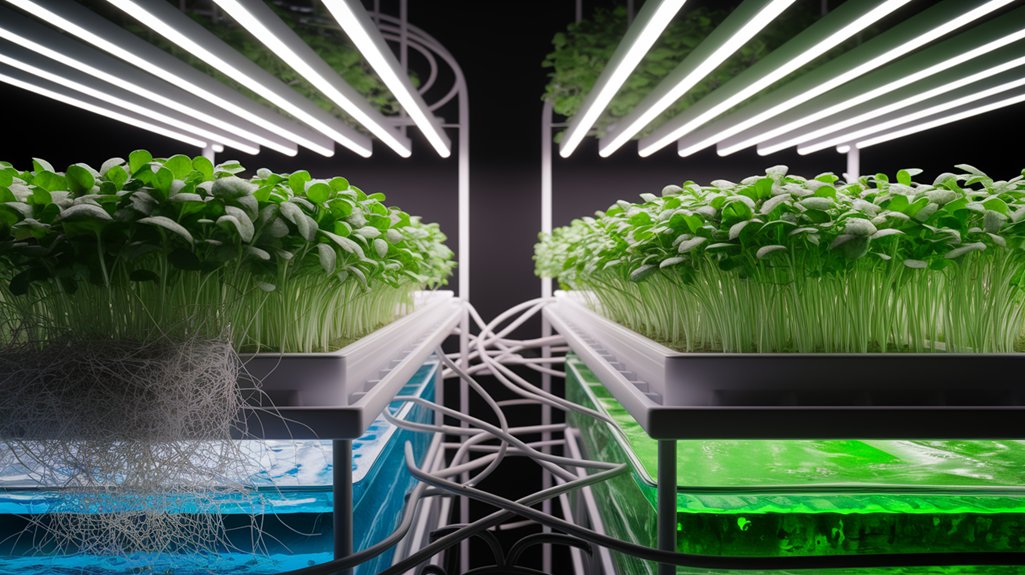
The journey to profitability through hydroponic microgreens isn’t without its hurdles. For starters, maintaining optimal nutrient levels is crucial; imbalances can lead to stunted growth or nutrient deficiencies.
I’ve found that monitoring pH and electrical conductivity requires constant attention and can be time-consuming. Additionally, pests and diseases can infiltrate even a controlled environment, complicating management efforts.
I’ve also experienced fluctuations in market demand, which can affect profitability; understanding consumer preferences is essential.
Finally, the initial investment in equipment and systems can be daunting, and ensuring a return on that investment takes meticulous planning and execution.
Balancing these challenges is key to succeeding in the hydroponic microgreens industry.
Environmental Impact and Sustainability
As I explore the environmental impact and sustainability of hydroponic microgreens, I find that this cultivation method can significantly reduce resource usage compared to traditional agriculture.
Hydroponics minimizes several environmental stressors, making it a compelling choice for sustainable farming. Here are some key benefits I’ve identified:
- Water Efficiency: Uses up to 90% less water than soil-based farming.
- Reduced Land Use: Requires less space and can be set up vertically.
- Lower Carbon Footprint: Less transportation needed, as these systems can be established in urban areas.
- No Pesticides: Limits chemical runoff and promotes healthier ecosystems.
- Year-Round Growth: Allows for continuous production, reducing food scarcity.
Tips for Successful Hydroponic Microgreen Cultivation
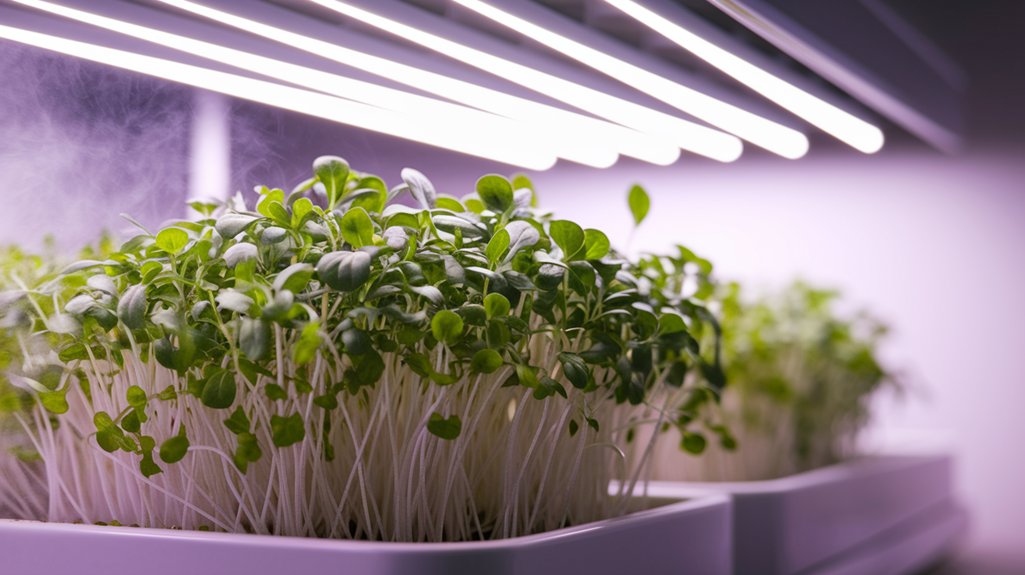
Having established the environmental benefits of hydroponic microgreens, I now want to share some practical tips for successful cultivation. First, ensure your nutrient solution is balanced, typically using an EC level of 1.5 to 2.5 mS/cm. Light is crucial; I recommend providing 12-16 hours of LED light daily. Temperature should remain between 65°F to 75°F for optimal growth. Keep humidity levels around 50-70% to prevent mold. Lastly, select the right seeds; varieties like radish and basil thrive in hydroponic systems.
| Tip | Details |
|---|---|
| Nutrient Solution | EC level: 1.5-2.5 mS/cm |
| Lighting | 12-16 hours of LED light daily |
| Temperature | 65°F to 75°F |
| Humidity | Maintain 50-70% humidity |
| Seed Selection | Use varieties like radish and basil |
Frequently Asked Questions
Can Hydroponic Microgreens Be Grown Indoors Year-Round?
Absolutely, I’ve found that growing hydroponic microgreens indoors year-round isn’t only feasible but also highly rewarding.
With the right setup, including adequate light, temperature control, and nutrient solutions, I can cultivate a variety of microgreens regardless of the season.
Research indicates that consistent environmental conditions enhance growth rates and yield.
I appreciate the flexibility of indoor hydroponic systems, allowing me to enjoy fresh greens anytime I want.
What Types of Seeds Are Best for Hydroponic Microgreens?
When choosing seeds for hydroponic microgreens, I’ve found that varieties like arugula, radish, and basil thrive exceptionally well.
These seeds germinate quickly and produce vibrant, nutrient-rich greens. Additionally, I prefer using organic seeds to ensure quality and flavor.
It’s crucial to select seeds specifically labeled for microgreens, as they offer better yields and taste.
Experimenting with different types can lead to discovering unique flavors and textures in my hydroponic garden.
How Long Does It Take to Harvest Hydroponic Microgreens?
When I grow hydroponic microgreens, I usually wait about 7 to 21 days before harvesting, depending on the variety.
For instance, radish microgreens can be ready in just 7 days, while sunflower takes around 14 days.
I’ve found that monitoring their growth closely is crucial; once they reach about 2 to 3 inches tall and develop their first true leaves, it’s the perfect time to harvest for optimal flavor and nutrition.
Are Hydroponic Microgreens Suitable for Beginners?
When I first started growing hydroponic microgreens, I found them quite suitable for beginners. The process is straightforward, requiring minimal equipment and space.
I researched various growth mediums and nutrient solutions, and I quickly learned that their fast growth cycle makes them rewarding. With just a bit of attention to detail and regular monitoring, I achieved success.
What Equipment Is Essential for Hydroponic Microgreen Cultivation?
When starting hydroponic microgreen cultivation, I’ve found a few essential pieces of equipment crucial.
First, I need a growing tray with drainage holes, which helps prevent waterlogging. A quality growing medium, like coconut coir or peat, is also necessary for root support.
Additionally, I invest in a light source, such as LED grow lights, to ensure optimal growth.
Lastly, a spray bottle for watering keeps the moisture levels just right for the seedlings.
Conclusion
In conclusion, hydroponic microgreens offer a compelling blend of nutritional benefits, space efficiency, and potential cost savings for urban gardeners. While challenges exist, such as initial setup and maintenance, the environmental advantages and sustainability practices make it a worthwhile endeavor. Ultimately, if you’re willing to invest time and resources, cultivating hydroponic microgreens can lead to a rewarding and health-conscious lifestyle choice, enhancing both your diet and your connection to sustainable agriculture.

